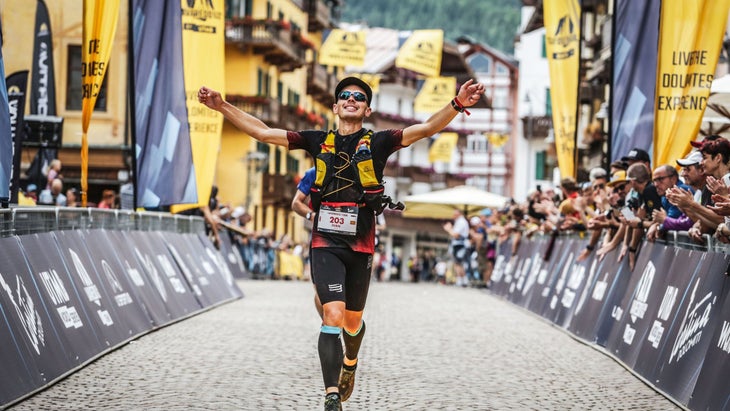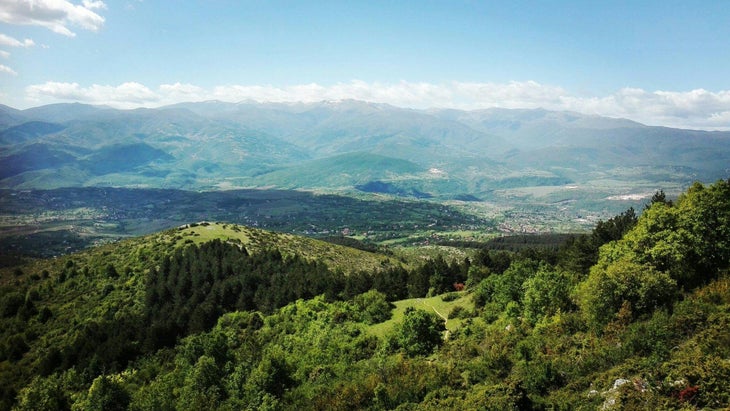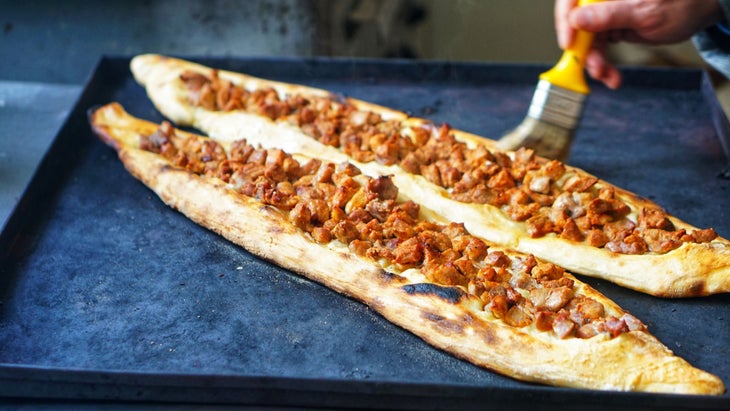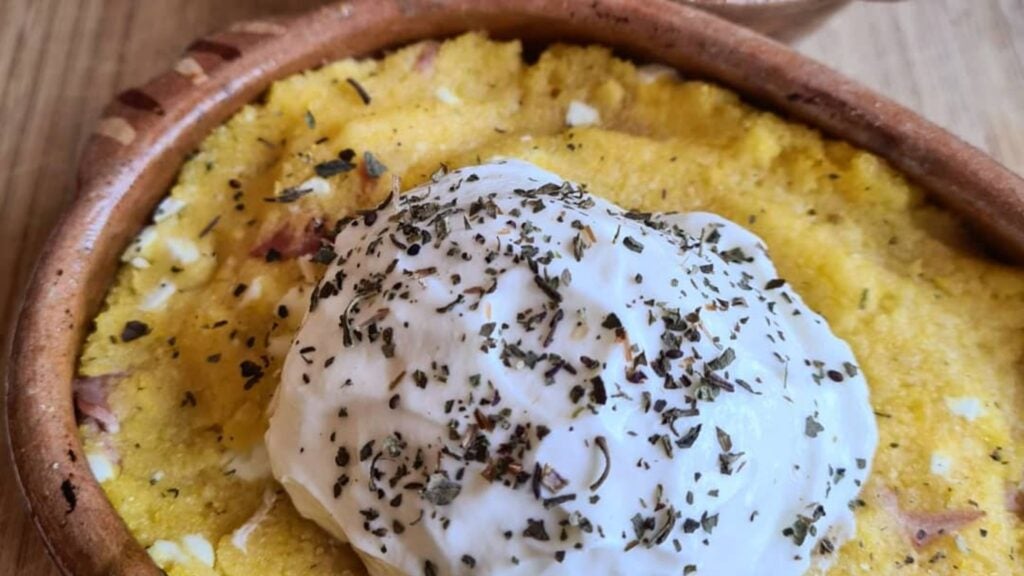New perk: Easily find new routes and hidden gems, upcoming running events, and more near you. Your weekly Local Running Newsletter has everything you need to lace up!
>”,”name”:”in-content-cta”,”type”:”link”}}”>Subscribe today.
Padded dirt trails that run like nature’s own red carpet, alpine scrambling that’ll pull the air out of your lungs, and a thigh-high run through brambles that make mincemeat out of your legs—that’s Macedonia’s 55-kilometer Pelister Unique Trail Marathon in a (painful) nutshell.
After tip-toeing a bit off the trail running map, from a U.S. perspective, with Türkiye’s Ephesus Ultra Marathon, I decided to go even further outside the box by signing up for Macedonia’s Pelister Unique Trail Marathon––a 55K (34.1-mile) slog with nearly 3,000 meters (9,800 feet) of elevation gain. And as always, I found the carb-iest delicacies the local cuisine has to offer to prepare myself for the challenge at hand before acquainting myself with whomever ends up at the top of the podium—inevitably a local, hours before me, who actually knows what they’re getting themselves into.
But first, we need to take a moment for a hasty, albeit wildly brief and incomplete history on Macedonia.
Making Sense of (North) Macedonia
In ancient times, the Balkan country was part of the Kingdom of Paeonia and later the Kingdom of Macedon, famous for Alexander the Great who was born in Pella in what is now northern Greece. It came under Roman rule and was later part of the Byzantine and Ottoman Empires, whose legacy is particularly obvious in the capital city Skopje’s old town and the ancient city of Ohrid. In the 20th century, it was part of Yugoslavia until its peaceful independence in 1991. In the 2019 Prespa Agreement with Greece, the country officially agreed to go by the name North Macedonia to satisfy Greek complaints (they have their own Macedonia) and help pave their way into the European Union.
Unsurprisingly, nobody on the ground refers to the country as such. The food is Macedonian, the train mishaps are Macedonian, the people are Macedonian. So at the risk of inadvertently causing an international diplomatic row as President Gordana Siljanovska-Davkova recently did when she referred to the country simply as “Macedonia” during her inauguration, I’ll honor how those who spoke with me referred to their country and follow suit.
Today, Macedonia is a rugged, landlocked country in the heart of the Balkans. The snow on the peaks of their more dramatic mountains melts away and feeds the lush greenery as the boiling summer months approach. Tourists are aplenty in Ohrid, Macedonia’s cobblestoned village on the shores of one of Europe’s oldest lakes. But the country is otherwise wonderfully untouched from the scourge of mass tourism with locals eager to welcome travelers who’re ready to go off the beaten path.
Trail Running in Macedonia

Ivan Radev is a 29-year-old doctor from a small town in the east, currently based in Skopje where he does most of his training thanks to the likes of Vodno Park and Matka Canyon right in his backyard. A relative newcomer to the sport, Radev started running just five years ago to stay fit after the end of his handball career.
“Friends got me hooked on this absolute addiction called ultrarunning,” he explains. It was an introduction the young Macedonian athlete didn’t know he needed at the time.
Radev didn’t spend much time outdoors as a kid and handball was a team sport, so spending time alone in the woods and on the hills was a new experience for him. That solitude helped him with his mental health and to develop his character, clarity, and purpose in life. For Radev, running has become his form of daily meditation.
“I think a lot of ultra and trail runners deal with their respective challenges through running,” he says. “And I think it’s a blessing that we get to do this. I wouldn’t give it up for anything.”
Radev believes other North Macedonians are taking note of the benefits of ultra and trail running. Anecdotally, he says he’s observed a rapid rise in trail running events in the country.

“We’re a very small, but mountainous country,” he explains. “Meaning it’s a one-or-two-hour drive to basically any mountain in the country, so you can navigate pretty easily and it’s not as time consuming as in bigger countries.”
That accessibility to the mountains has led to a number of stellar races popping up over the years: Chupino’s 60K Trinity Trail, Vodno-Matka Trail Marathon, and the Titov Vrv Skyrace. But Radev’s favorite is the 107K Ohrid Ultra Trail. The grueling race runs around the UNESCO World Heritage Site of Ohrid and Galičica National Park with more than 16,000 feet of elevation. Radev managed to finish second in his first attempt. The next time, but pulled himself from the race after a bear encounter. He won it outright in his third go.
That said, Radev counts the Pelister Unique Trail Marathon (PUTM) as the country’s most beautiful race of them all thanks to the course’s diversity of tamed, forested trails, and alpine terrain. (Though it probably also doesn’t hurt that he topped the podium on June 22.)
“This was my first time participating in the 55K distance of the event and I’m really glad I did it,” he says. “Everything a trail runner wants, a trail runner gets in this race. Good organization, enthusiasm and atmosphere. The terrain was really challenging and the hot temperatures going up to [104 degrees Fahrenheit] didn’t make it any easier, but it’s part of the game and you have to overcome it. I raced together with the second finisher and I must admit that he pushed me to my limits. Kudos to him.”
Running in the Footsteps of Heroes
Nenad Lazic is the creator and ongoing race director for PUTM. Born in Croatia, Lazic has been based in Bitola for more than a decade after spending some time in Switzerland, where he learned a delightfully bouncy Swiss-German that he uses with me.
PUTM is now in its third year, created out of Lazic’s personal passion for trail running and to show the trail running world, whether from Macedonia or a suburb outside of Cleveland, what Bitola and Pelister have to offer. This region, he adds, is notable for its historic connection to the First World War. Parts of today’s Pelister National Park were part of the Macedonian Front, also known as the Salonika Front. This front was established after the Allies landed in Thessaloniki (Salonika) in 1915 to support Serbia against the Central Powers.
The front extended through Macedonia and included significant battles around the Baba Mountain range, the peak of which is a particularly taxing part of the race that requires scrambling over massive boulders at high-altitude. The rugged terrain played a strategic role in the military operations of the time. The front saw considerable military activity from 1916 to 1918, involving forces from several countries, including France, Britain, Serbia, Greece, and Bulgaria.
Fortunately, the infamous trenches are long gone and replaced by small groups of masochists choosing to spend their Saturday getting lost in the park. Lazic says that the trail that runners traverse is nicknamed the “Heroes’ Footsteps,” acknowledging the history of the region.
“When we run these trails, we can imagine everything that a soldier had to endure,” he says, noting the demanding nature of the course. “We show a lot of respect for this mountain and we’re proud that we’re able to put on an event like this here.”
Macedonian Muscle
Given the country’s history, there’s significant culinary overlap with its Balkan neighbors. For Radev, Macedonian cuisine thrives off its blend of east and west. As an example, he counts moussaka (beef and eggplant lasagna) as one of his favorite dishes—something you’re likely to find on just about any menu of a traditional Greek restaurant. But his go-to dinner is bakardan, also known as kačamak—a type of cornmeal porridge comfort dish popular throughout the Balkans. (I think of it as Balkan ugali.) It’s typically eaten with boiled eggs, bacon, cheese, or greek yogurt.
“For me, it’s the perfect mix of carbs and protein,” he says. “It’s all natural, easy to make, and easy on the stomach!”
After a race, he might indulge in some pastrmajlija or ‘Balkan pizza.’ It’s a type of flatbread topped with salted and dried meat. Imagine a pizza, Georgian khachapuri, and Turkish pide had a ménage à trois. The result is basically pastrmajlija in all its carb-heavy, cheesy glory.

Looking ahead, Radev has to prepare for the biggest race of his life—UTMB in Chamonix.
“Life’s given me a chance to run among the legends of our sport and in the most spectacular setting in the Alps,” he says. That means focusing on his training, and invariably, his fuel.
In that spirit, let’s tuck into a bowl of bakardan.
How to Make Bakardan/Kačamak
- 500g of corn flour
- 1.5L water
- 3 Tbsp. of sunflower seed oil
- Salt, to taste
- Feta cheese, to taste
- Greek yogurt, optional on the side
- In a pot, bring water with sunflower seed oil to a boil, add the corn flour, and a pinch of salt.
- Reduce the heat to medium-low and mix continuously until the corn flour is well incorporated and thickened, about 2-3 minutes.
- Optionally, shred some feta cheese directly into the pot and stir.
- Remove from heat and serve immediately with an optional garnish of remaining feta cheese and a side of greek yogurt.
